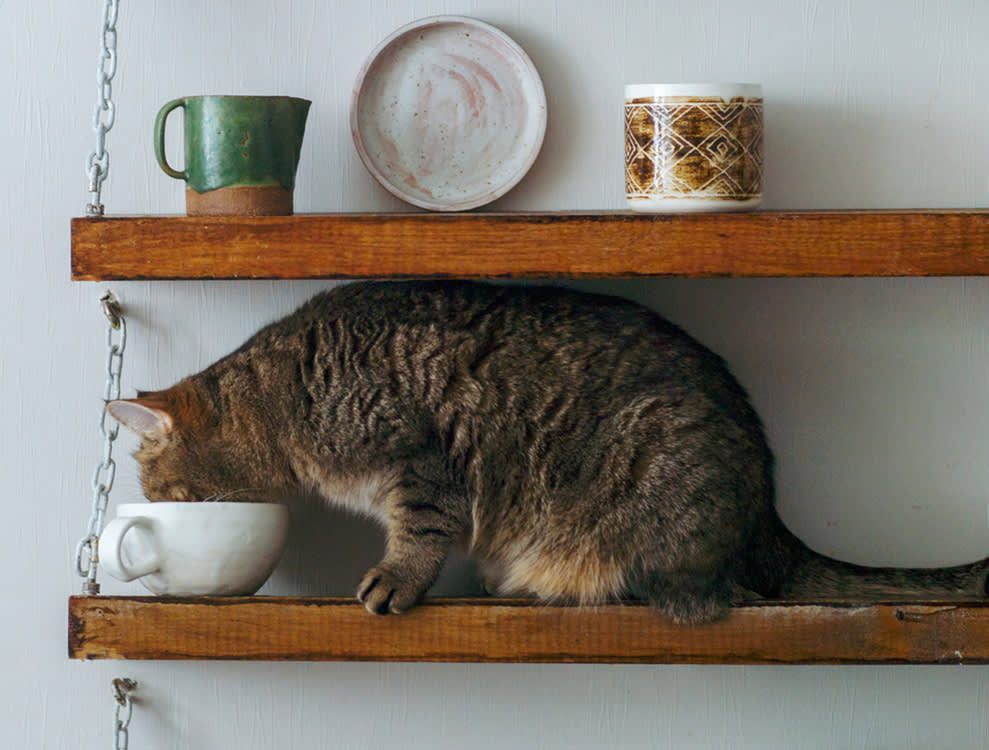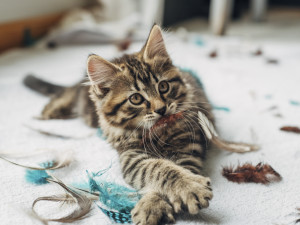How to Scent Train Your Cat
A veterinarian on how nosework and scent enrichment can strengthen your bond.

share article
It’s no secret that cats are often underestimated. If you’ve long bemoaned this fact because you’ve seen firsthand how much your cat is capable of, you’re going to want to stay apprised of the latest feat of feline kind: nosework. And no, we aren’t talking about cats’ nosey tendencies.
Nosework is a form of scent detection in which the animal’s task is to find the “target odor” using their sense of smell. While it’s a common exercise among dog trainers (think of the ultra-astute K9 dog squad you pass while going through TSA), it has only recently become a popular exercise for cats. Below, we break down all things nosework, including why it could bring you and your cat closer, and even get an expert’s stamp of approval. We asked Dr. Annette Louviere, a licensed veterinarian specializing in cats and an active member of the American Associate of Feline Practitioners, for some pro tips.
What is nosework?
Nosework is an act of seeking out a target odor — whether that’s for a treat, toy, or meal — on the part of your pet. The trainer (you) hides the scented item in a non-obvious, but still accessible location for the subject (your cat) to sniff out.
Animals have an incredibly strong sense of smell compared to humans — especially dogs, who have “hundreds of millions more” scent receptor cells than we do, according to the New York Times best-selling author and dog cognition researcher Alexandra Horowitz. This makes them particularly predisposed to the type of puzzle solving enrichment that nosework provides.
Why should I scent-train my cat?
It requires little to no training experience, and it provides pets with a productive activity to release their stagnant energy, exercise, and reinforce positive behaviors. Plus, it’s fun for both you and your cat. It may even give you renewed appreciation for your cat’s problem-solving abilities and excitement for something other than the click of their dinner bowl touching the ground.
How do I get my cat started with nosework?
There are many different ways to enrich a cat’s environment and mind. According to Dr. Louviere, “One example is using their own innate curiosity (and love of treats) by introducing a snuffle or sniff mat to make your cat work their minds by sniffing out their treats.” This should act as an introduction to the scent-detection required of nosework and may help your cat get the hang of things.
First, set up a waiting area, like a crate or separate room, for your cat so you have time to prepare the obstacle course for their search. Then, hide the item with the odor you want them to uncover in a clever place, like under a cardboard box or piece of furniture they wouldn’t think to look behind. Looking for a pro tip? Dr. Louviere suggests attracting your cat to parts of the home they wouldn’t ordinarily seek out, by “placing mats or puzzles in different areas.”
Can I use something other than food or treats for nosework?
Definitely. The only issue with this is that, in the cases of catnip or silvervine, some cats have interest in them and some don’t. You’d essentially be adding an additional step to show the cat that when they uncover the catnip, they can anticipate a treat afterwards.
What are some potential challenges of nosework?
There are a few obstacles that trainers face while introducing nosework to their cats. The first is showing cats the inherent value in what they’re seeking out with their noses. Whereas dogs use their noses instinctively and are constantly sniffing to discover things about their environment, cats don’t have quite as strong of a sense of smell or urgency to use their noses, so it has to be taught. The expectation for cats to catch on to nosework right away is lower — which is better in a way, because the objective should be enrichment, not punishment.
The second is keeping their target odor hidden while still allowing cats to uncover the odor to self-reward. Unless you purchase specialized containers that are light enough for a cat to uncover, you may be setting up paper bags at odd angles and praying a breeze doesn’t come through the room.
The final potential challenge is keeping cats quiet while in their designated waiting areas. If they’ve participated in nosework before, they’ll be excited at the prospect of uncovering a treat and may vocalize this anticipation while they wait. You can give them their favorite toy, snuffle mat, or scratching pad to work on while they exercise patience. But if your biggest challenge is that your cat is excited to participate in nosework, there are worse problems to have.

Avery Felman
Avery is a writer and producer. She has written for numerous publications, including Refinery29, BuzzFeed, and V Magazine. When she’s not at her computer, you can find her reading, practicing her Greek on Duolingo, and delving into the Sex and the City discourse. She lives in Brooklyn, New York with her husband and their cat, Chicken, who rules with an iron fist.

